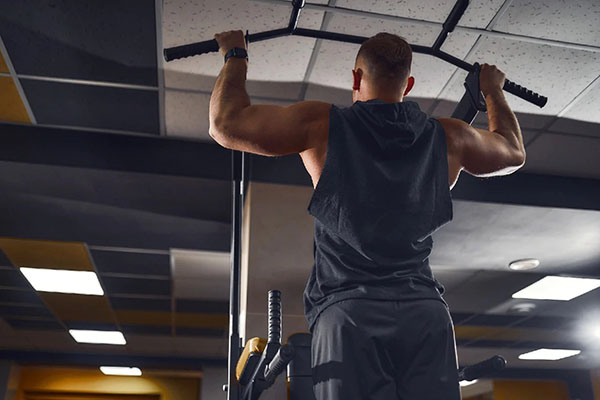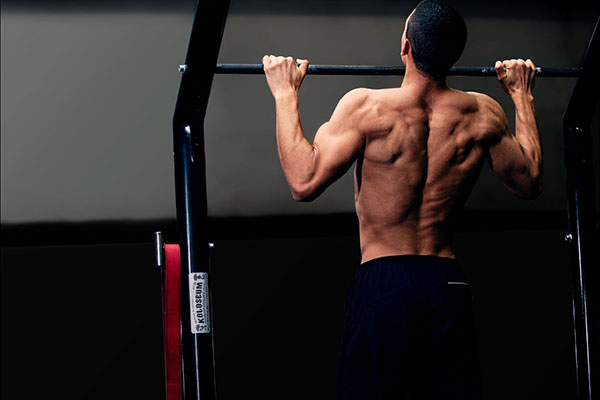Pull-ups are a popular exercise that primarily targets the muscles in the upper body, particularly the back, arms, and shoulders. However, there has been a belief among some individuals that engaging in pull-ups regularly can actually contribute to an increase in height. In this article, we will explore whether there is any truth to this claim and delve into the factors that influence human height. So, can pull-ups really increase height? Let’s find out.
Does Pull-Ups affect Height?
Calf raises are a simple exercise that can strengthen the calf muscles and the muscles around the ankle, while also elongating and toning the calves. It is important to perform this exercise through its full range of motion. The primary benefit of calf raises is to target the muscles used for standing and walking in daily activities. Additionally, they can help strengthen the Achilles tendon and improve the stability of the ankle and knee joints.
Now, how do calf raises exercises contribute to increasing your height?
In reality, there is no scientific study that specifically addresses this claim. The calves consist of two important muscles: the gastrocnemius and the soleus. The soleus muscle is engaged when you flex your foot, while the gastrocnemius muscle is activated when you point your foot.
However, incorporating calf raises into your exercise routine is generally considered beneficial for enhancing your ability to jump higher. This is because calf raises help develop stronger gastrocnemius and soleus muscles, which are crucial for improving vertical jump performance.
Individuals who participate in basketball or other activities that involve jumping are constantly seeking ways to increase their jumping ability. Jumping primarily relies on four major muscle groups: the core muscles, quadriceps, gluteus maximus, and the gastrocnemius and soleus muscles. Each of these muscle groups forms a chain that is connected to the ground when you jump. If any of these links in the chain are weak, it will limit your jumping height.
By engaging in calf raises and improving the strength of your calf muscles, you can potentially improve your jumping ability and excel in a variety of exercises that require vertical movements. This can open up new possibilities for achieving a growth spurt in your athletic performance.

How do you do a pull-up correctly?
To perform a pull-up correctly, follow these steps:
- Start by approaching a pull-up bar with your palms facing away from you and slightly wider than shoulder-width apart. Your arms should be fully extended.
- Engage your core muscles by pulling your shoulder blades down and back. This will help stabilize your upper body during the exercise.
- Begin the movement by exhaling and pulling yourself upward using your arms. Focus on engaging your back muscles, particularly the muscles between your shoulder blades.
- Continue pulling until your chin reaches or goes slightly above the level of the pull-up bar. Maintain control and avoid swinging or using momentum to complete the movement.
- Once you reach the top position, slowly lower yourself back down while inhaling. Keep your core engaged and control the descent to fully benefit from the exercise.
- Repeat the pull-up for the desired number of repetitions. Aim for proper form and quality of movement rather than quantity.
Here are some additional tips to ensure proper pull-up technique:
- Avoid using excessive momentum or swinging your body during the movement. This can decrease the effectiveness of the exercise and increase the risk of injury.
- Keep your body straight throughout the pull-up, avoiding excessive arching of the back or swinging of the legs.
- If you’re a beginner or find pull-ups challenging, you can use assistance methods such as resistance bands, a pull-up machine, or perform eccentric pull-ups (where you focus on the lowering phase of the movement) to build strength gradually.
- Gradually increase the difficulty of your pull-ups by focusing on slow and controlled movements, adding weight if necessary, or progressing to more advanced variations like wide-grip or weighted pull-ups.
Remember, practicing proper form is crucial for maximizing the benefits of pull-ups and reducing the risk of injury.
How to perform calf raises for beginners?
To perform calf raises for beginners, here’s a step-by-step guide:
- Stand upright with your feet hip-width apart, near the edge of a step or an elevated surface. You can hold onto a railing or wall for balance if needed.
- Slowly rise up onto the balls of your feet, lifting your heels off the ground. Keep your core engaged and maintain a straight posture throughout the exercise.
- Hold the raised position for a second or two, feeling the stretch in your calves.
- Lower your heels back down to the starting position, allowing your calves to stretch fully.
- Repeat the movement for the desired number of repetitions. Start with a manageable number, such as 10 to 15 repetitions, and gradually increase as your calf muscles get stronger.
Here are a few additional tips to keep in mind:
- Perform the exercise in a slow and controlled manner, focusing on the contraction and stretch of the calf muscles.
- Keep your body stable throughout the exercise, avoiding any excessive swaying or leaning.
- You can perform calf raises with both feet simultaneously or focus on one leg at a time to increase the intensity.
- To challenge yourself further, you can hold onto a dumbbell or use a resistance band for added resistance.
- As a beginner, it’s important to listen to your body and start with a suitable range of motion and intensity. Gradually increase the difficulty as your calf muscles adapt and become stronger.
Incorporating calf raises into your regular exercise routine can help strengthen your calf muscles and improve ankle stability. Remember to consult with a healthcare professional or fitness trainer if you have any specific concerns or limitations.
Does Pull-Ups Increase Growth Hormone?
Pull-ups can potentially increase the release of growth hormone in the body. However, it is important to note that the magnitude of this increase may not be substantial or have a significant impact on overall growth hormone levels.
Several studies have suggested that intense resistance exercises, such as pull-ups, can transiently stimulate the release of growth hormone. The specific mechanism behind this is not fully understood, but it is believed to be related to the stress placed on the muscles and the subsequent signaling within the body.
It is worth mentioning that the increase in growth hormone levels from exercise is generally short-lived and returns to baseline relatively quickly after the exercise session. Additionally, the release of growth hormone during exercise can vary among individuals and may be influenced by factors such as age, fitness level, and overall health.
While pull-ups and other resistance exercises may have some impact on growth hormone release, it is important to understand that growth hormone is primarily involved in childhood growth and development. In adults, the effects of growth hormone on overall height or stature are minimal.
It is crucial to maintain realistic expectations and not rely solely on pull-ups or exercise to influence growth hormone levels for the purpose of increasing height or promoting growth. A balanced approach that includes proper nutrition, rest, and overall healthy lifestyle habits is key for optimal growth and development. If you have specific concerns or goals related to growth hormone, it is recommended to consult with a healthcare professional for personalized advice.
What are calf raises variations to try?
There are several variations of calf raises that you can try to target your calf muscles from different angles and add variety to your workout routine. Here are a few examples:
Single-Leg Calf Raises: Perform calf raises on one leg at a time. This variation adds an extra challenge and allows you to focus on each calf individually.
Seated Calf Raises: Sit on a chair or a calf raise machine with your feet resting on a raised platform. Push your toes against the platform to raise your heels, targeting the soleus muscle in a seated position.
Donkey Calf Raises: This variation requires a partner or a calf raise machine. With your hands on a stable surface for support, position yourself in a bent-over position with your partner sitting on your lower back. Perform calf raises while your partner provides resistance by sitting on you.
Toe Raises: Instead of lifting your heels, keep your heels on the ground and lift your toes as high as possible. This variation focuses on strengthening the muscles on the front of your lower leg, particularly the tibialis anterior.
Jumping Calf Raises: Start in a regular standing position and explosively jump off the ground, propelling yourself upward using your calf muscles. Land softly and repeat the movement in a controlled manner. This variation adds an element of plyometrics to your calf training, helping to improve power and explosiveness.
Incline Calf Raises: Find an inclined surface, such as a ramp or an adjustable calf raise machine, and position your toes on the higher end. Perform calf raises with your heels hanging off the edge of the incline, targeting your calves from a different angle.
Remember to adjust the intensity and difficulty level of these variations based on your fitness level and comfort. It’s always a good idea to consult with a fitness professional or trainer to ensure proper form and technique when trying new exercises.

What are the health benefits of calf raises?
Calf raises offer several health benefits, including:
- Strengthening Calf Muscles: Calf raises primarily target the calf muscles, namely the gastrocnemius and soleus. Regularly performing calf raises can help strengthen and tone these muscles, enhancing lower leg stability and overall lower body strength.
- Improved Ankle Stability: Calf raises work the muscles surrounding the ankle joint, including the gastrocnemius, soleus, and tibialis anterior. Strengthening these muscles can enhance ankle stability, which is important for balance, walking, and other weight-bearing activities.
- Injury Prevention: Strong calf muscles and improved ankle stability provided by calf raises can help reduce the risk of ankle sprains and other lower leg injuries. By strengthening the muscles and improving their flexibility, calf raises contribute to better overall lower body biomechanics.
- Enhanced Athletic Performance: Calf strength and ankle stability play a crucial role in various athletic activities. Performing calf raises can improve jump height, running efficiency, and overall athletic performance. Strong calf muscles also contribute to improved power for movements like sprinting and jumping.
- Rehabilitation and Physical Therapy: Calf raises are often incorporated into rehabilitation programs for lower leg injuries or conditions, such as Achilles tendonitis, shin splints, and calf strains. These exercises help to rebuild strength, restore range of motion, and promote recovery.
- Improved Posture: Calf raises engage the muscles of the lower leg and can indirectly contribute to better posture. By strengthening the calf muscles and promoting proper alignment of the lower body, calf raises can help alleviate issues associated with poor posture.
Remember to start with appropriate intensity and gradually increase difficulty as your calf muscles become stronger. It is always advisable to consult with a healthcare professional or fitness trainer before starting any new exercise routine, especially if you have pre-existing medical conditions or concerns.
Tips to consider when practicing calf raises
When practicing calf raises, here are some tips to consider:
- Proper Form: Maintain proper form throughout the exercise. Keep your body aligned, engage your core muscles, and avoid excessive leaning or swaying. Focus on lifting and lowering your heels using the calf muscles.
- Full Range of Motion: Aim for a full range of motion during calf raises. Lower your heels as far as possible to stretch the calf muscles, and then rise up onto the balls of your feet as high as you can to fully contract the calves.
- Gradual Progression: Start with a manageable number of repetitions and gradually increase as your calf muscles get stronger. Avoid pushing yourself too hard too quickly, as it may lead to muscle strain or fatigue.
- Breathing: Breathe naturally throughout the exercise. Exhale as you lift your heels and inhale as you lower them back down. Avoid holding your breath, as it can create unnecessary tension in the body.
- Balance and Stability: Maintain balance and stability during calf raises. If needed, hold onto a stable surface, such as a wall or railing, for support. As you progress, challenge yourself to perform calf raises without assistance to improve balance and stability.
- Tempo and Control: Perform calf raises in a controlled manner, focusing on the contraction and stretch of the calf muscles. Avoid using momentum or swinging your body to lift your heels, as it reduces the effectiveness of the exercise.
- Rest and Recovery: Allow your calf muscles time to rest and recover between workout sessions. Overtraining can lead to muscle fatigue and potential injury. Incorporate rest days into your training program and listen to your body’s signals.
- Additional Resistance: Once you have mastered bodyweight calf raises, you can add resistance to further challenge your muscles. This can be done by holding dumbbells, using a weighted vest, or using a resistance band around the top of your feet.
Remember to consult with a healthcare professional or fitness trainer if you have any specific concerns, limitations, or medical conditions before starting a new exercise routine.
Conclusion
In conclusion, pull-ups are a valuable exercise for strengthening the upper body and improving overall fitness. However, they do not directly contribute to an increase in height. Height growth is primarily determined by genetics and other factors like nutrition and hormonal balance. While pull-ups offer numerous benefits, it is important to have realistic expectations when it comes to their impact on height.
- Related post: 15 Best Healthy Drinks That Make You Taller

Erik Kelly with more than 30 years of working in the field of technology and games. Erik Kelly will answer all your questions related to the latest technology products, new game reviews at Timrim.com website.